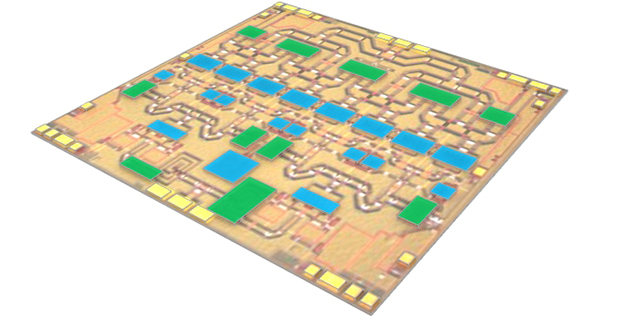Chip-friendly magnetic materials combined with microelectronics could provide a portal to a new generation of magnetics-boosted circuits
A newly-announced DARPA program is betting that unprecedented on-chip integration of workhorse electronic components, such as transistors and capacitors, with less-familiar magnetic components with names like circulators and isolators, will open an expansive pathway to more capable electromagnetic systems. The Magnetic, Miniaturized, and Monolithically Integrated Components (M3IC), program will orchestrate research into miniaturized magnetic components with a goal of catalyzing chip-based innovations in radar and other radio frequency (RF) systems—and satisfying growing military and civilian demands for new ways to maneuver within the increasingly crowded electromagnetic spectrum.
“Magnetic materials let us access unique physics and functionality that we cannot duplicate with electronic components,” said Dev Palmer, program manager for M3IC (pronounced “M-Cubic”), which is slated for a five-year run with total funding up to $26 million. “M3IC could change the way we design RF circuits and systems.”
The physics and functionality Palmer refers to reside in the principles of electromagnetism, which govern RF signals. It is has been far easier for engineers to design, deploy, and miniaturize RF signal processing in electronics than with magnetic devices, yet some signal processing functions are more effectively achieved by manipulating magnetic fields. One reason for the slow adoption of magnetic components has been the difficulties inherent in miniaturizing and integrating such components directly on chips, alongside electronic circuitry. Among other issues, the magnetic fields that accompany these components can interfere with electronic behavior on chips in unpredictable and undesirable ways. This is why designers of radio, radar, and other RF systems typically segregate the magnetic functions they need off-chip, a limitation that results in bulkier, heavier, and more power-hungry systems compared to the ones that the M3IC program are anticipated to enable.
“M3IC is about distributing the magnetic functionality throughout the circuit instead of pushing it out to the edges,” said Palmer. “It’s about designing and fabricating circuits holistically, so the designer can supercharge state-of-the-art RF electronic circuits with magnetic functionality wherever it is needed, and only where it is needed, in one monolithic chip.”
In particular, Palmer said, seamless co-design and integration of magnetic materials and semiconductors should lead to new generations of more compact microwave monolithically integrated circuits, or MMICs—a class of chips for RF technology developers that offer wider frequency ranges (bandwidth), better stability, and lower power needs than conventional chips.
A Broad Agency Announcement, DARPA-BAA-16-36, describing the program and the procedure for submitting proposals, was published today on FedBizOpps.com https://ow.ly/xqGq301l2Vy.
The new DARPA program is taking on three challenges. The first challenge falls under the category of basic materials science and engineering: to develop techniques for growing and patterning nearly flawless films of magnetic materials (such as hexaferrites and multilayer superlattices with tailorable magnetic properties) on semiconductor wafers while preserving the properties of both the magnetic materials and the semiconductor microcircuitry. The second challenge is to develop the field- and circuit-modeling software necessary for accurate and efficient design of integrated magnetic devices. The third challenge is for engineers to use the new materials and modeling tools to devise and deliver new and improved electromagnetic functionality in smaller, power-efficient packages. By addressing these challenges, the M3IC program will provide the materials and tools necessary to improve the design and performance of existing magnetic components, such as circulators and frequency selective limiters (FSL), and to catalyze innovations of novel, magnetics-enabled, RF-processing technologies.
Frequency selective limiters are especially valuable given the recent proliferation of RF devices in both civilian and military settings, which is increasing the risk of interference. “These limiters, or FSLs, filter out signals that are intentionally or unintentionally trying to jam your reception or damage your receiver,” Palmer explained. “But unlike current receiver protection systems, which work by means of complex sense-analyze-and-actuate loops, FSLs achieve that goal in a much simpler way, as a natural result of their magnetic physics. The ability to produce and integrate miniaturized, power-efficient, interference-management directly onto the billions of RF-involved chips of the future could become a real game changer.”
By integrating the expected advances of the M3IC program into chips endowed with the specialized semiconducting material gallium nitride (GaN), the program also could help provide the military Services with expansive higher-frequency refuge from the overcrowded microwave portion of the spectrum (below 30 Gigahertz). In these already well-subscribed frequency ranges, interfering RF waves can appear as false targets in electronic warfare systems, degrade communications links, and damage sensitive system components. M3IC could ultimately provide the integrated magnetic components necessary to mitigate these problems. By opening the way for a new magneto-electronic design paradigm, the M3IC program also could lead to miniaturized radar systems, higher-capacity channels for transferring data and information, and higher-power RF systems, which could translate into such capabilities as jam-resistance, farther-reaching communications, and more powerful electronic warfare systems.
“By adding magnetics to the MMIC designer’s palette, we hope to open up a whole new design spectrum for RF systems,” Palmer said. “If we get this right, we will bootstrap magnetic component technology to the level of sophistication and integration we enjoy with today’s commercial and military electronics.”
Image Caption: Integrating magnetic components (green) with high-density microelectronic circuity (blue) could open doors to new electromagnetic microsystems.



















